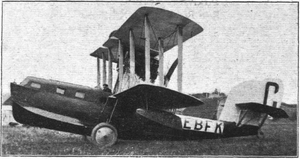Supermarine Sea Eagle
| Sea Eagle | |
|---|---|

| |
| Sea Eagle G-EBFK | |
| Role | Biplane, airliner flying boat |
| Manufacturer | Supermarine |
| Designer | R. J. Mitchell |
| First flight | June 1923 |
| Introduction | 25 September 1923 |
| Retired | 1928 |
| Primary user | British Marine Air Navigation Co Ltd |
| Produced | 1923 |
| Number built | 3 |
The Supermarine Sea Eagle was a British, passenger–carrying, amphibious flying boat. It was designed and built by the Supermarine Aviation Works for its subsidiary, the British Marine Air Navigation Co Ltd, to be used on their cross-channel route between Southampton, the Channel Islands and France.
Service
Three civilian aircraft were constructed, G-EBFK, G-EBGR and G-EBGS and the regular service between Southampton and
The wooden hull of the surviving Sea Eagle, G-EBGR, was retained by Vickers until 1949, when they presented it to the British Overseas Airways Corporation; BOAC burnt it in 1954 because of a lack of storage space.[3]
Variants
The Supermarine Sheldrake used the hull of the Sea Eagle and the wings of the Seagull with a tractor engine installation. A single example was built.
The Supermarine Scarab was a military flying-boat, based on the Sea Eagle and Sheldrake but with a pusher engine, specially designed for the Spanish Navy. Twelve were eventually built and delivery to the Spanish Naval Air Service for use in the bomber/reconnaissance role during the Rif War. It was fitted with a .303 in (7.7 mm) Lewis gun and a bomb load of 1,000 lb 454 kg.[4]
Operators
Specifications
Data from Supermarine Aircraft since 1914.[5]
General characteristics
- Crew: 2 (pilot and mechanic)
- Capacity: 6 passengers
- Length: 37 ft 4 in (11.38 m)
- Wingspan: 46 ft (14 m)
- Width: 21 ft 1 in (6.43 m) folded
- Height: 15 ft 11 in (4.85 m)
- Wing area: 620 sq ft (58 m2)
- Empty weight: 3,950 lb (1,792 kg)
- Gross weight: 6,050 lb (2,744 kg)
- Max takeoff weight: 6,500 lb (2,948 kg) (overload)
- Powerplant: 1 × Rolls-Royce Eagle IXV-12 Water-cooled piston engine, 360 hp (270 kW)
- Propellers: 4-bladed fixed-pitch wooden pusher propeller
Performance
- Maximum speed: 93 mph (150 km/h, 81 kn)
- Range: 230 mi (370 km, 200 nmi)
- Time to altitude: 5,000 ft (1,524 m) in 19 minutes
See also
References
- Bibliography
- Andrews C.F. and Morgan, E.B. Supermarine Aircraft since 1914. London:Putnam, 1987. ISBN 0-85177-800-3.
- Jackson, A.J. British Civil Aircraft 1919–1972:Volume III. London:Putnam, 1988. ISBN 0-85177-818-6.
- London, Peter. British Flying Boats. Sutton Publishers Ltd. 2003. ISBN 0-7509-2695-3
- "The Supermarine 'Sea Eagle'", Flight, vol. XV, issue 26, pp. 351–352, 28 June 1923.
